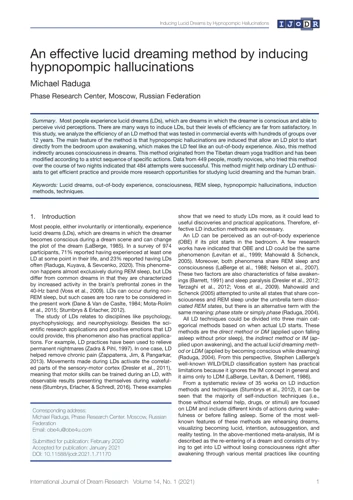Have you ever had a dream that felt so real, you didn’t want to wake up? What if you could control that dream and explore limitless possibilities? It may sound like something out of a sci-fi movie, but it’s possible through the fascinating phenomenon of lucid dreaming. For those unfamiliar with the concept, it may seem like a mysterious and impossible task. However, with the right techniques and a bit of patience, anyone can learn to lucid dream. In this article, we will explore what lucid dreaming is, the benefits of practicing it, and 10 tips for beginners to become successful at lucid dreaming. Get ready to embark on an incredible journey of self-discovery and enhance your dream life like never before.
Contents
- What is Lucid Dreaming?
- Benefits of Lucid Dreaming
- Tip #1: Keep a Dream Journal
- Tip #2: Reality Checks
- Tip #3: Set Your Intention
- Tip #4: Practice Visualization
- Tip #5: Avoid Stimulants
- Tip #6: Create a Relaxing Bedtime Routine
- Tip #7: Use Supplements and Aromatherapy
- Tip #8: Practice Meditation
- Tip #9: Try the WILD Technique
- Tip #10: Be Patient and Persistent
- Conclusion
-
Frequently Asked Questions
- What is the difference between a regular dream and a lucid dream?
- Is lucid dreaming a real phenomenon?
- Is lucid dreaming safe?
- Can anyone learn to lucid dream?
- What are the benefits of lucid dreaming?
- Can lucid dreaming be used to overcome phobias?
- Are there any risks to lucid dreaming?
- What is a dream journal, and why is it important for lucid dreaming?
- What are reality checks, and how do they help with lucid dreaming?
- Are there any supplements or aromatherapy that can help with lucid dreaming?
- References
What is Lucid Dreaming?

Have you ever had a dream that was so vivid and realistic that you could swear it was real? What if you could control that dream and do anything you wanted? This is the concept behind lucid dreaming, a phenomenon that has fascinated people for centuries. Lucid dreaming is a state where you are aware that you are dreaming and can control your dreams. It’s like having a personal virtual reality experience every time you go to sleep. But how does this phenomenon work? Let’s take a closer look.
Definition of Lucid Dreaming
Lucid dreaming is a state of consciousness during a dream, where the dreamer becomes aware that they are dreaming, and can manipulate the dream’s content as they wish. This creates a unique ability to explore and control the dream world in ways that are impossible in waking life.
The following table highlights the key elements of the definition of lucid dreaming:
| State of consciousness | Lucid dreaming is a state of consciousness that occurs during a dream. |
| Awareness | The dreamer becomes aware that they are dreaming, and can recognize the dream world as distinct from waking reality. |
| Manipulation | Lucid dreamers have the ability to manipulate the content of their dreams, such as controlling the dream characters and environment. |
| Exploration | Lucid dreaming enables the dreamer to explore and experience the dream world in unique and creative ways. |
| Impossibility in waking life | The abilities and experiences of lucid dreaming are impossible to replicate in waking life. |
Lucid dreaming offers a fascinating and multi-dimensional experience that can be both exciting and rewarding for those who learn to master it. By becoming aware of and controlling the dream world, lucid dreamers can unlock new possibilities for personal growth, creativity, and spiritual exploration.
What Lucid Dreaming Feels Like
One of the most fascinating aspects of lucid dreaming is the experience itself. It is a surreal feeling that cannot be described in words. Let’s take a look at some of the sensations that you can expect to feel during a lucid dream:
Surreal: Lucid dreaming feels like entering a whole new world – a world that is different yet strangely familiar. It is an out-of-the-box experience that can leave you feeling amused and bewildered.
Control: The ability to control your dream is what sets lucid dreaming apart from regular dreaming. You can do anything your heart desires – fly, breathe underwater, or even teleport!
Realism: Many lucid dreamers report that their dreams feel incredibly realistic, even more so than waking life. This sense of realism is what allows you to fully experience and enjoy the dream world.
Empowerment: Lucid dreaming can be an immensely empowering experience. It allows you to take control of your subconscious mind and conquer your deepest fears and insecurities.
Euphoria: The feeling of euphoria during a lucid dream is incomparable to anything else. It is a feeling of complete bliss and happiness that can leave you feeling uplifted long after the dream has ended.
Lucid dreaming is a unique and amazing experience that opens up a whole new world of possibilities. It is a chance to take control of your mind and explore the deepest corners of your subconscious.
Benefits of Lucid Dreaming

Lucid dreaming is a fascinating phenomenon that has intrigued researchers and laypeople alike for centuries. It offers a wealth of benefits that are not limited to just having fun in your sleep. Indeed, the potential advantages of lucid dreaming extend far beyond its entertainment value. This includes everything from resolving past traumas to improving creativity and mental health. In this section, we will explore the many benefits of lucid dreaming and how it can improve your life in unexpected and profound ways.
Increased Creativity
One of the benefits of lucid dreaming is the potential for increased creativity. During lucid dreams, people often have access to their subconscious mind, which can lead to unique and innovative ideas. This can be especially beneficial for those in creative fields such as writing, music, and art.
Through lucid dreaming, individuals may be able to explore and experiment with different ideas and concepts that they may not have considered before. In fact, many famous artists and inventors have reported using lucid dreaming to help them come up with new ideas and solutions to problems.
Studies have shown that people who engage in lucid dreaming tend to have more creative solutions to problems in their waking life. This is likely because lucid dreaming allows people to access different parts of their brain and make new connections between ideas.
If you are looking to boost your creativity through lucid dreaming, there are a few things you can try. One is to set the intention of exploring new ideas and concepts during your dreams. You can also practice visualization techniques before going to sleep to help stimulate creativity.
It’s important to note that while lucid dreaming can be a helpful tool for enhancing creativity, it’s not a guarantee. It may take some experimentation and practice to find what works best for you. By staying patient and persistent, however, you may find that lucid dreaming can unlock a whole new world of creative potential.
| Increased Creativity |
|---|
| Access to subconscious mind |
| Unique and innovative ideas |
| Exploration of new concepts |
| Stimulates different parts of the brain |
| Practice visualization techniques |
Overcoming Nightmares and Anxiety
Lucid dreaming can also be a useful tool for overcoming nightmares and anxiety. When we experience a nightmare, our brain views it as a real threat and can cause feelings of intense anxiety and fear. However, in a lucid dream, we have the power to take control and change the outcome of the dream.
| Technique | Description |
|---|---|
| Nightmare Rehearsal | In this technique, you rehearse the nightmare scenario in your mind during waking hours until you feel more comfortable with it. This can help reduce the emotional response when the nightmare occurs in a dream. |
| Confront and Transform | Instead of running from the source of your fear in a dream, confront it head-on and transform it into something positive. For example, if you are being chased by a monster, turn around and confront it, realizing that it is a manifestation of your subconscious mind. |
| Self-Talk | Use self-talk in a dream to calm yourself down and remind yourself that it is just a dream. For example, saying “this is just a dream, I am safe” can help reduce anxiety. |
| Relaxation | Practice relaxation techniques such as deep breathing or visualization in a dream to reduce anxiety and tension. |
By using these techniques, you can overcome nightmares and anxiety, allowing you to get a better night’s rest and improve your overall well-being.
Improved Sleep Quality
Lucid dreaming can also lead to improved sleep quality, as it allows individuals to become more aware and in control of their dreams. Poor sleep quality can lead to a variety of health problems such as depression, obesity, and diabetes. However, incorporating lucid dreaming into your sleep routine may help alleviate these issues.
Here are some benefits of lucid dreaming on sleep quality:
- Enhanced restfulness: Lucid dreaming allows individuals to wake up feeling more refreshed and energized, possibly due to the fact that they are able to experience a more fulfilling and relaxing dream state.
- Reduced sleep interruptions: Often, those who experience vivid dreams may wake up frequently throughout the night, which can lead to disrupted sleep. However, lucid dreaming can help individuals reduce these interruptions by providing a sense of relaxation and control.
- Less reliance on medication: Many people turn to sleeping pills to help them fall asleep or stay asleep throughout the night. However, by practicing lucid dreaming, individuals may be able to achieve a similar sense of relaxation and control over their sleep without the need for medication.
Incorporating lucid dreaming into your sleep routine may be a great way to enhance your overall health and well-being.
Tip #1: Keep a Dream Journal

One of the most important things that beginner lucid dreamers can do is to keep a dream journal. Writing down your dreams regularly can help you to remember them more vividly and accurately, and it can also help you to identify patterns and recurring themes in your dreams. By keeping a record of your dreams over time, you may even begin to notice signs or cues that can alert you to the fact that you are dreaming.
To start a dream journal, simply keep a notebook and pen by your bedside or use a digital journaling app. As soon as you wake up, try to recall as much of your dream as possible and write it down. Don’t worry too much about spelling or grammar – the focus should be on capturing as many details as you can, including the setting, characters, and emotions you experienced in the dream.
It can also be helpful to read through your dream journal regularly and look for patterns or recurring themes. This can give you valuable insight into your own thought processes and subconscious mind, which can in turn help you to recognize when you are dreaming.
Keeping a dream journal is a crucial step in becoming successful at lucid dreaming. It takes dedication and consistency, but the rewards are well worth the effort. With regular practice, you may find that you are able to achieve a greater level of lucidity in your dreams and unlock the full potential of your subconscious mind.
Tip #2: Reality Checks

One of the most effective techniques for becoming proficient at lucid dreaming is implementing reality checks into your daily routine. Reality checks involve questioning your surroundings and regularly checking whether or not you are dreaming.
Why are Reality Checks Important for Lucid Dreaming?
It’s easy to get caught up in a dream and not realize that you are actually asleep. By performing reality checks while awake, you train your brain to question the reality of your surroundings. This means that you’re more likely to do the same when you’re asleep, leading to the realization that you’re in a dream and the ability to take control of it.
How to Perform Reality Checks
The most popular reality check is to count your fingers. When you’re awake, take a moment to look at your hands and count your fingers. Do this multiple times throughout the day. Over time, your brain will start to recognize this routine and start performing the same checks when you’re asleep.
Another popular reality check is to read a passage of text multiple times. If you’re dreaming, the text will appear to change or become nonsensical over time. This is because dreaming often involves distorted or unrealistic imagery.
Other Types of Reality Checks
There are many other reality checks that you can perform, including looking at a mirror, checking digital time displays, and attempting to push your finger through your other hand. The key is to find the method that works best for you and incorporate it into your daily routine.
Make Reality Checks a Habit
To be effective, reality checks should be performed multiple times throughout the day. Consistency is key in making reality checks a habit. Set reminders on your phone or computer to perform checks at regular intervals throughout the day, and make a conscious effort to be aware of your surroundings and question their reality.
By implementing reality checks into your daily routine, you’ll increase your chances of lucid dreaming and take a major step towards becoming a proficient lucid dreamer.
Tip #3: Set Your Intention

Setting your intention is a critical step towards becoming successful at lucid dreaming. Intention refers to your purpose or goal in pursuing lucid dreaming. It could be to overcome nightmares and anxiety, to improve your creativity, or to explore new realms of consciousness. Whatever your intention may be, it is important to keep it firmly in mind during the process of lucid dreaming.
To help set your intention, start by meditating and reflecting on why you want to lucid dream. Think about the benefits you hope to gain and the experiences you hope to have. Once you have a clear intention, write it down and read it regularly. This will help reinforce your goal and keep it at the forefront of your mind.
Another way to set your intention is by using affirmations. Affirmations are positive statements that affirm your objective, repeated aloud or in your mind. For example, “I will have a lucid dream tonight,” or “I am capable of becoming conscious in my dreams.” The repetition of affirmations can help program your subconscious mind to accept and focus on your intention.
Additionally, try to visualize yourself successfully achieving your goal. Imagine what it would be like to control your dreams, overcome your fears, or explore new worlds. Visualization can help create a sense of familiarity with your intention, making it more likely that you will achieve it in your dreams.
Setting your intention is a crucial part of becoming successful at lucid dreaming. By meditating, using affirmations, and visualization techniques, you can clarify your goals and focus your attention on achieving them. With practice and persistence, you can become a lucid dreamer and unlock the full potential of your dreams.
Tip #4: Practice Visualization

Visualization is a powerful tool that can help you improve your lucid dreaming skills. By practicing visualization techniques regularly, you can train your mind to create clear and vivid images. This can make it easier for you to recognize when you are dreaming and to take control of your dreams.
One effective visualization technique is to imagine yourself becoming aware that you are dreaming. You can do this by picturing in your mind a scenario where you suddenly realize that you are dreaming. For example, you may imagine yourself looking at your hands and suddenly realizing that they are distorted or blurry.
Another technique is to visualize specific dream scenarios that you want to experience. For example, you may want to have a lucid dream where you are flying or talking to a specific person. By picturing these scenarios in your mind and imagining how they would feel, you can increase the likelihood of experiencing them in your dreams.
It is important to practice visualization regularly, ideally before bed or during meditation. This can help train your mind to be more alert and aware during your dreams. As you become more skilled at visualization, you may find that you are able to control your dream scenarios with ease, leading to more frequent and fulfilling lucid dreams.
However, it is important to note that visualization alone does not guarantee lucid dreams. It is just one of the many tools that you can use to improve your skills. It is important to combine visualization with other tips and techniques, such as reality checks and setting intentions, to increase your chances of success.
Tip #5: Avoid Stimulants

If you want to increase your chances of having a lucid dream, it is vital to avoid stimulants before bedtime. Stimulants are substances that stimulate the central nervous system, making it harder to fall asleep and decreasing the likelihood of entering into the dream state. Common examples of stimulants include caffeine, nicotine, and alcohol.
Caffeine: Coffee, tea, and energy drinks are all products that contain caffeine. It is best to avoid consuming these beverages before bedtime. Experts suggest limiting caffeine consumption to no more than 400 milligrams per day, and four to six hours before bedtime.
Nicotine: Nicotine is an addictive chemical found in cigarettes and e-cigarettes. Not only is it harmful to your health, but it can also disrupt your sleep patterns. It is best to avoid smoking or using nicotine products before going to bed.
Alcohol: Many people believe that alcohol can help improve sleep, but the truth is that it can lead to fragmented and poor-quality sleep. It can interfere with your ability to enter the dream state. Thus, it is best to avoid alcohol consumption before going to bed.
By avoiding these stimulants, you can ensure that your body and mind are calm and relaxed before bedtime, making it easier to fall asleep and enter the dream state. This, in turn, increases your chances of having a lucid dream. Instead, you can try drinking a warm cup of herbal tea, such as chamomile, which is known for its relaxing properties.
Tip #6: Create a Relaxing Bedtime Routine

Getting a good night’s rest is essential to experiencing lucid dreams, and creating a relaxing bedtime routine can help get you into the right mindset for lucid dreaming. Here are some things you can do to create a relaxing bedtime routine.
1. Turn off electronic devices: The blue light emitted by electronic devices can disrupt your circadian rhythms, making it harder to fall asleep. So, turn off your phone, tablet, and laptop at least an hour before you head to bed.
2. Take a relaxing bath or shower: Taking a warm bath or shower can help relax your body and mind. You can add some essential oils like lavender or chamomile to enhance the relaxation experience further. These oils can also help induce lucid dreams as they are known to promote relaxation and calmness.
3. Read a book: Reading a book or a magazine before bed can help calm your mind and reduce stress. It is essential to read something relaxing and not highly stimulating, so it doesn’t activate your mind before sleeping.
4. Practice gentle stretches or yoga: Practicing gentle stretches or yoga can help relax your muscles and release any tension that has built up during the day. This can be done for 15-20 minutes and can help your body and mind get into a more relaxed state.
5. Practice deep breathing: Deep breathing is a simple relaxation technique that can be done anywhere, anytime. Taking a few deep breaths before bed can help calm your body and mind, reducing stress and anxiety levels. It can also enhance your chances of experiencing lucid dreams as it helps to maintain a relaxed state even during sleep.
Incorporating these activities into your bedtime routine can help you relax and set the stage for lucid dreaming. Remember, consistency is key, so try to maintain your bedtime routine every day if possible.
Tip #7: Use Supplements and Aromatherapy

Supplements and aromatherapy can be helpful tools for those looking to increase their chances of having lucid dreams. While they are not necessary, they can be useful in promoting relaxation and improving sleep quality, both of which are important factors in achieving lucid dreams.
Supplements: There are several supplements that have been shown to be effective in promoting lucid dreaming. One such supplement is melatonin, a hormone naturally produced by the body that helps regulate sleep-wake cycles. Taking melatonin supplements before bed can help promote relaxation, reduce the time it takes to fall asleep, and increase the likelihood of having vivid dreams, including lucid dreams. Another supplement that has been shown to be effective is galantamine, a cholinesterase inhibitor that helps improve memory and cognitive function. It is thought to enhance the brain’s ability to enter the REM (rapid eye movement) phase of sleep, which is when most dreaming occurs.
Aromatherapy: Aromatherapy is the use of essential oils to promote health and well-being. Certain essential oils have been found to be effective in promoting relaxation and improving sleep quality, both of which can help increase the chances of having lucid dreams. Lavender oil, for example, is well-known for its calming and relaxing properties. It can be used in a diffuser or added to a bath before bedtime to promote relaxation and reduce anxiety. Another essential oil that has been shown to be effective is jasmine oil. It has a soothing and uplifting scent that can help promote relaxation and reduce stress.
It’s important to note that while supplements and aromatherapy can be helpful in promoting relaxation and improving sleep quality, they are not a substitute for healthy sleep habits. It’s important to get enough sleep each night, avoid caffeine and alcohol before bed, and create a relaxing bedtime routine to help promote restful sleep. Additionally, it’s always a good idea to consult with a healthcare professional before starting any new supplements or aromatherapy treatments.
Tip #8: Practice Meditation

One effective approach to develop your ability to lucid dream is to incorporate meditation into your daily routine. Meditation is a powerful tool to calm your mind and increase awareness. Through the practice of meditation, you can develop a more focused and relaxed state of mind, which can enhance your chances of lucid dreaming.
What is Meditation?
Meditation is the practice of focusing your attention on a specific object, thought, or activity to bring about mental clarity and emotional calmness. This practice has been used for centuries to improve overall well-being, reduce stress, and cultivate a sense of inner peace.
How Does Meditation Help with Lucid Dreaming?
Meditation trains your mind to remain focused, and this can be beneficial when you want to induce a lucid dream. Through regular practice, you will develop greater awareness and control over your thoughts and emotions. When you become more conscious of your mental states, you can learn to recognize when you are dreaming, and this can lead to lucid dreaming.
How to Practice Meditation for Lucid Dreaming
To practice meditation, find a quiet place where you won’t be disturbed, sit comfortably with your back straight and close your eyes. Focus on your breath and bring your attention back to your breath as many times as necessary. Stay with your breath, allowing thoughts to come and go without losing your focus or judgment. With regular practice, you will develop greater control over your thoughts, and this can increase your chances of having lucid dreams.
Other Tips for Using Meditation for Lucid Dreaming
To increase your chances of having lucid dreams through meditation, you can try some additional techniques like:
– Adding a lucid dreaming visualization to your meditation practice.
– Practicing meditation before sleep to help you relax and ease into the dream state.
– Using a guided meditation specifically designed to induce lucid dreams.
– Trying some breathing exercises like taking deep breaths before sleep to calm your mind and enhance focus.
Incorporating meditation into your daily routine can have a significant impact on your ability to lucid dream. With regular practice, you will become more aware of your mental states, and this can lead to greater control over your dreams. So, start meditating today, and enhance your chances of having lucid dreams!
Tip #9: Try the WILD Technique

Another helpful tip to become successful at lucid dreaming is to try the Wake-Initiated Lucid Dreaming (WILD) technique. This technique involves going directly from a waking state into a state of lucid dreaming. While it may take some practice to perfect, many lucid dreaming enthusiasts swear by it for its effectiveness.
To start with this technique, try going to bed early and waking up after about 5 hours of sleep. Stay awake for 30-60 minutes while focusing on your intention to have a lucid dream. During this time, you can perform some gentle stretches or meditation to relax your body and mind.
Next, lay down comfortably and focus your attention on your body. Start to visualize a dream scene and imagine yourself in it. Allow yourself to sink deeper into relaxation and let the dream scene become more vivid. You may also try repeating a mantra like “I am dreaming” to affirm your intention.
As you continue to visualize and relax, you may start to notice a loss of sensation in your body or the onset of sleep paralysis. This is a sign that you are transitioning into a lucid dream state. Try to remain calm and focused, and trust that your mind will enter the dream state naturally.
It is important to note that the WILD technique may not work for everyone, and it can take some time and practice to master. But with patience and persistence, this technique can be a powerful tool for experiencing lucid dreams.
Tip #10: Be Patient and Persistent
Achieving success in anything requires patience and persistence, and lucid dreaming is no different. It takes time to train your mind to become aware in your dreams, and it’s not something that usually happens overnight.
Patience is key when it comes to lucid dreaming. It’s important to remember that everyone’s journey is different, and some people may have more success than others. Don’t get discouraged if you don’t see immediate results, and don’t give up on the practice. It may take weeks or even months to have your first lucid dream, but the experience is worth the wait.
Persistence is also vital, as regular practice is essential for success. Even when you don’t have a lucid dream for a while, it’s important to keep up with your dream journal, reality checks, and other techniques. By staying consistent with your practice, you’ll be more likely to achieve lucidity in your dreams.
It’s natural to get frustrated or feel stuck at times, but remember that any progress is still progress. Some nights you may feel like you didn’t make any progress, but if you keep practicing, you’ll eventually have a breakthrough.
It’s important to be patient and persistent when it comes to lucid dreaming. Keep practicing and don’t give up, even if it takes a while to see results. With time and dedication, you can achieve the incredible experience of lucid dreaming.
Conclusion
In conclusion, lucid dreaming can be a fascinating and rewarding experience for those who are willing to put in the effort to develop the skill. By keeping a dream journal, practicing reality checks, setting intentions, practicing visualization, avoiding stimulants, creating a relaxing bedtime routine, using supplements and aromatherapy, practicing meditation, trying the WILD technique, and being patient and persistent, beginners can become successful at lucid dreaming.
However, it is important to remember that everyone’s experiences with lucid dreaming will be unique, and there is no one “right” way to do it. It may take time and practice to achieve lucid dreaming, but the benefits can be extraordinary. From increased creativity to overcoming nightmares and anxiety, the rewards of lucid dreaming are worth the effort.
So if you are a beginner looking to become successful at lucid dreaming, start by incorporating these tips into your daily routine and be open to the possibilities that lucid dreaming can offer. With dedication and persistence, you can develop the ability to control your dreams and unlock the limitless potential of your subconscious mind. So go ahead and explore the fascinating world of lucid dreaming – your dreams are waiting for you.
Frequently Asked Questions
What is the difference between a regular dream and a lucid dream?
A regular dream is one in which the dreamer has no control over the content of the dream, whereas in a lucid dream, the dreamer is aware they are dreaming and can actively participate in the dream.
Is lucid dreaming a real phenomenon?
Yes, lucid dreaming has been scientifically proven to exist.
Is lucid dreaming safe?
Yes, lucid dreaming is generally considered safe as long as the dreamer is mentally and emotionally stable.
Can anyone learn to lucid dream?
Yes, with practice, anyone can learn to lucid dream.
What are the benefits of lucid dreaming?
The benefits of lucid dreaming include increased creativity, overcoming nightmares and anxiety, and improved sleep quality.
Can lucid dreaming be used to overcome phobias?
Yes, lucid dreaming can be used to overcome phobias by allowing the dreamer to confront and manage their fears in a controlled environment.
Are there any risks to lucid dreaming?
While there are no inherent risks to lucid dreaming, some people may experience sleep disturbances or difficulty distinguishing between dreams and reality if they become too focused on lucid dreaming.
What is a dream journal, and why is it important for lucid dreaming?
A dream journal is a record of a dreamer’s dreams that can be used to identify patterns and clues to help with lucid dreaming. It is important because it can help the dreamer become more aware of their dreams.
What are reality checks, and how do they help with lucid dreaming?
Reality checks are actions taken by the dreamer during waking life to help them determine whether they are dreaming or awake. They can help with lucid dreaming by increasing the dreamer’s self-awareness and ability to recognize when they are dreaming.
Are there any supplements or aromatherapy that can help with lucid dreaming?
Yes, supplements such as melatonin and valerian root, as well as certain essential oils like lavender and chamomile, have been shown to help with lucid dreaming.







